
The Internet of things, can, and is a great idea, but one big problem prevents to implement it now in full. The fact that all these smart electrical devices require power sources, but it often happens that the devices themselves are so small that the battery and nowhere to install. Fortunately, Dutch engineers, it seems, are the closest to solving this problem.
Scientists from the Technical University of Eindhoven (the Netherlands) created a tiny (the area of only 2 square mm) wireless temperature sensor that receives the necessary energy to work via radio waves, transmitted over the wireless network. All you need for this chip, the closest router. Once the chip is getting enough power, it begins to work.
As mentioned above, the size of the chip is just 2 millimeters square. The weight is 1.6 grams. Inside it there is a tiny antenna that picks up energy from a nearby source of radio waves. Once the chip is sufficiently charged, it turns on and starts to measure the ambient temperature, and then transmits to the receiver a signal through those same radio waves.
The sensor is able to work under layers of paint, plaster and even concrete, which can be very useful in those areas where they can be used such chips. One option, for example, are systems for tracking optimal temperature conditions in the premises. According to the scientists who created the chip, similar technology can be used to create motion sensors. Again for use in the home. The system will capture the human presence in the room and automatically turn on or off lights. Such a system exists today, however they are very expensive. In turn, such wireless chips, according to scientists, a very low cost — about 20 cents apiece.
Currently, the performance of the sensor is severely restricted. He is able to receive and transmit signals at a distance of 2.5 cm. However, in the future it is planned to increase the work radius up to 5 meters.
